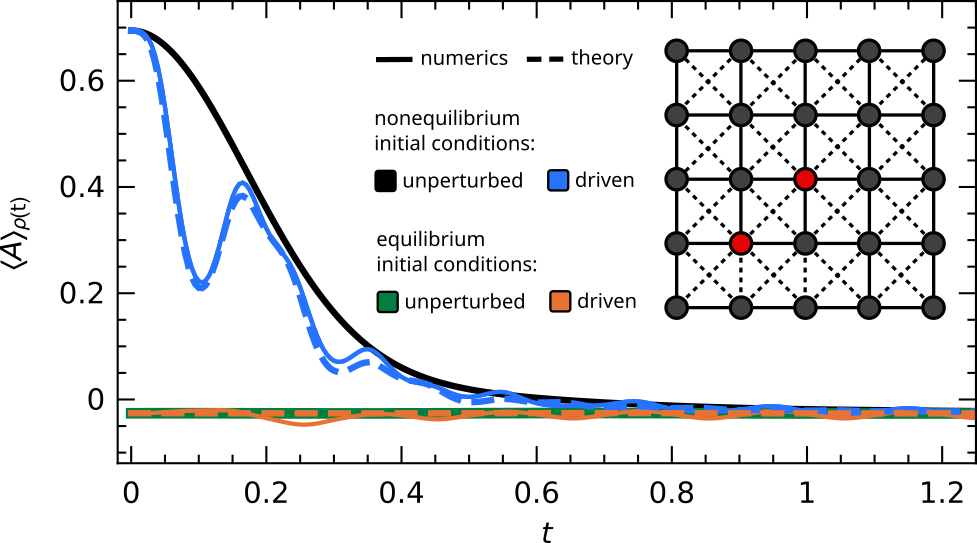Dr Lennart Dabelow has research shows that thermal equilibrium is remarkably resilient against perturbations
Lennart Dabelow, Lecturer in Applied Mathematics at Queen Mary’s School of Mathematical Sciences, and Peter Reimann, Professor at Bielefeld University, Germany, reveal that the response of large systems to periodic driving can be strongly suppressed near thermal equilibrium.

The sketched system of interacting spins (elementary magnets) is prepared out of equilibrium. If left alone (black line), the magnetization correlation between two central spins (red in the sketch) relaxes to thermal equilibrium (green line). With additional time-periodic driving (blue line), a strong reaction is observed initially, but it dies out as the system approaches equilibrium. Similarly, a system prepared in equilibrium (orange line) shows barely any response to identical driving.
It is an empirical fact that macroscopic systems, if left alone, evolve towards a state of thermal equilibrium, which appears macroscopically homogeneous and stationary. Take a bottle of sparkling water, for example. As long as the cap is closed, the bottle is isolated from its environment and the pressure inside the bottle is typically higher than the ambient pressure. If we slowly open the bottle, microscopic gas particles can move from the bottle to the environment and vice versa. Because of the pressure difference, the joint system of bottle and environment is now out of equilibrium, but this difference will gradually diminish until the system reaches an equilibrium state of homogeneous pressure.
Given this natural tendency of macroscopic systems to thermalize, some effort is required to push a system away from equilibrium. But how strongly will you need to drive the system to observe a noticeable response?
A recent study by Lennart Dabelow and Peter Reimann finds that large classes of many-body systems are surprisingly resilient against time-dependent driving as long as the undriven system is close to thermal equilibrium. This phenomenon occurs when the driving is such that it does not heat up the system too quickly. Compared to the vibrant reaction observed away from equilibrium under otherwise identical circumstances, the response is then strongly suppressed for systems near equilibrium.
The study uses quantum mechanics as the microscopic theory to describe the system’s basic degrees of freedom, e.g. the constituting atoms and molecules. The insight is based on numerical experiments and a newly developed analytical theory that can predict the observable dynamics of such many-body quantum systems under time-dependent forcing. Besides providing a fundamental link between the macroscopic phenomenology and the microscopic dynamics of large systems, the theory may be used to describe aspects of cold-atom experiments or general-purpose quantum computers, which utilize time-dependent manipulations of so-called qubits (“quantum bits”) to outperform classical computers in certain tasks.
Lennart Dabelow recently joined Queen Mary University of London as a lecturer and was a postdoctoral researcher in the group of Masahito Ueda at the RIKEN Center for Emergent Matter Science in Japan before. Peter Reimann is a professor at Bielefeld University in Germany. The full study entitled “Stalled response near thermal equilibrium in periodically driven systems” was published in Nature Communications and is available online.